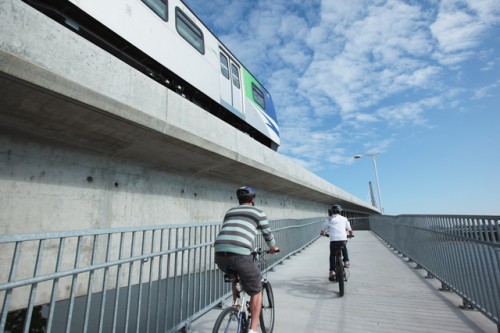Transit = Urban Recovery
Transit = Urban Recovery

COVID-19 has dimmed the vibrancy of urban centres across the globe and spurred some to question whether we are witnessing “the end of cities.”
The pandemic has disrupted our lives in so many ways that it’s hard to predict what tomorrow will bring, let alone which changes will become permanent. However, I firmly believe that cities will rise again – with a recovery driven by transit.
After all, cities have been at the heart of every prosperous society. We are, as Harvard economist Edward Glaeser puts it, “an urban species,” living off the fruits of collaboration that cities – and public transportation – provide.
But the pandemic is testing the key tenets of what makes cities and transit work, namely bringing people together. Public transport is facing a crisis unlike any other since the late-1940s. What then took place over two decades – an 80 per cent erosion in transit ridership, brought on by the rise of the personal car and suburbia – was realized in just two weeks earlier this year, as COVID-19 emerged. In response, public health measures have kept people safe, but have stunted transit.
As a society, we can’t afford to repeat the same mistakes and allow transit to whither. Effective public transport is synonymous with equitable and sustainable urban development. Metro Vancouver was a leader on this front before the pandemic, with record-setting ridership that led North America. Notably, the sharpest increase in transit ridership was in communities outside the City of Vancouver.
Unfortunately, in the short-term, I believe the return of traffic congestion is inevitable. We have already witnessed a dramatic decline in transit ridership and a sharp rebound in traffic congestion. Early data show that driving in Metro Vancouver is already up by around four per cent compared to one year ago. I think we can all agree the future we don’t want is one with more congestion.
That’s why it’s critical that we rebuild public confidence in the safety of transit, through initiatives such as TransLink’s Safe Operating Action Plan and our recently launched Open Call for Innovation, focused on improving the cleanliness and safety of the system. Now is the time for our industry, worldwide and here in the Lower Mainland, to seek out and embrace innovations.
Looking beyond the immediate future, we need to contemplate whether the rapid societal changes initiated by this crisis, such as social distancing and tele-commuting, will persist. If so, that will have significant implications on transit ridership – a crucial consideration for TransLink, which depends heavily on fares for operating revenue.

We also need to ask: how might our urban landscapes change? Already we’ve seen cities reimagining their streetscapes to create more space for pedestrians, cyclists, and restaurants. Many of these changes could positively improve the livability and vibrancy of our cities I believe we need to consider how transit can complement these measures and contribute to this new urban experience.
Time will tell which changes will hold, but TransLink welcomes conversations on how our region can increase efficiency while balancing diverse priorities throughout the transportation system. Improving the livability of Metro Vancouver is central to our mission and drives our organization every day.
As we help the region Build Back Better, I believe the region’s values – which we learned about through our largest-ever engagement in Transport 2050 – will endure and help inform the decisions we need to make together. Transport 2050 will also help us navigate the next 30 years, with its inevitable population and economic growth, and face the trio of challenges presented by affordability, congestion, and climate change.
Now, more than ever, we need to keep our bold vision for the future alive and create a vision for sustainable transportation in 2050. We need to advance our plans to build high-capacity transit and capital projects, which create jobs and economic activity for our region. And we need to continue working with partners to ensure there is a plethora of mobility options for all people in the Lower Mainland.
The pandemic will bend our trajectory, but ultimately, we remain committed to the same bold vision for transportation. In the end, vibrant public transportation isn’t just a symbol for the comeback of cities, it’s not even a key ingredient. Transit is urban recovery.
Kevin Desmond, Former TransLink CEO
Kevin Desmond is the former Chief Executive Officer of TransLink, Metro Vancouver’s transportation authority that moves 500,000 people every day. He oversaw planning, financing, and management of a region-wide multimodal transit network that includes bus, rapid transit, passenger ferry, para-transit, and commuter train service, with over 8,000 employees.





